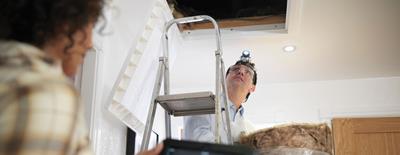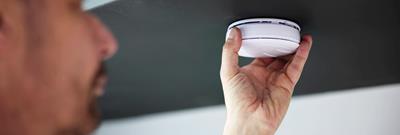
Don’t dash for a plumber when your home isn’t heating up correctly, but the boiler works. The chances are you just need to bleed your radiators.
Bleeding a radiator is a relatively easy job. All you need are a few tools and our following tips, and your home will feel toasty in no time.
How to bleed a radiator
It’s easy to take radiators for granted, so you notice when they start making weird noises or don’t warm up. It’s not tricky to bleed a radiator if you follow our step-by-step guide.
EASY AS HACK
We recommend bleeding your radiators yearly when winter starts, and you’re turning your heating back on. It only takes a few minutes and could save you money and keep your home warm.
At a glance
- Turn your central heating off and allow the radiators to cool
- Hold a towel or bowl under the bleed valve to catch any water run-off
- Insert the bleed key into the bleed valve and turn it anticlockwise
What is bleeding a radiator?
Bleeding a radiator means letting out any trapped air so the hot water in it and the central heating system circulate evenly.
The most likely cause of cold spots is air pockets preventing hot water from circulating correctly inside the radiator.
What tools do you need to bleed a radiator?
Bleeding a radiator is a relatively easy task requiring a few household items and a small tool called a radiator bleed key.
- Radiator bleed key – you may already have this, or you can buy these universal-sized keys online
- An old towel – anything like a flannel or drying-up cloth will do to absorb water trickles from the valve
- A jug or tray – you’ll need a container to soak up any water that comes out of the radiator before it reaches the floor
Step-by-step instructions for bleeding your radiator
- You shouldn’t bleed a radiator when the heating is on, so start by turning off the boiler and giving the radiators time to get cold (about 1 hour) – this reduces the risk of burns from hot water
- Find the bleed valve – it will be at one end of the radiator at the top and looks like a metal nut with a slot for a flathead screwdriver or a square-shaped metal bar inside a round socket
- Place your container on the floor under the radiator to catch drips from the valve if you open it too far
- Hold a cloth under the bleed valve and insert the radiator bleed key
- Slowly turn the key anticlockwise until air starts escaping from the valve
- Stop when the air begins to escape (it sounds like hissing) and let a little water exit the valve before turning the key clockwise to retighten and close it
- If it’s still leaking a bit, turn the valve a little more but without overtightening it, as it could damage it
- Repeat this on every radiator that needs attention – or all of them if you want to be sure there’s no air left in the heating system
- Check that there’s no fault code displayed on the boiler or that the pressure has decreased. The pressure should have been from 1.0 to 1.5 bars before you switched it on. Turn your heating back on and check that the radiators are free of air pockets and heating up.
Signs you should bleed your radiator
You should bleed your radiator at the start of winter each year when you first turn your heating on. The classic signs you need to bleed your radiator include:
- Radiators take longer than average to heat up
- Gurgling and knocking noises when your heating is on
- Cold patches on the radiator at the top.
Find out when you should turn on your heating.
Why do you need to bleed your radiator?
- It keeps your heating running at its best, so your home stays comfortable and warm
- You use less energy with an efficient system, saving on energy bills
- Maintenance extends your heating system’s lifespan, which also saves you money
Troubleshooting tips for bleeding your radiators
Can you bleed a radiator without a bleed key?
You can bleed a radiator using a flathead screwdriver if you don’t have a bleed key and the radiator has a slotted bleed screw.
An Allen key or pliers is an alternative for older radiators with a square or hexagonal valve.
What to do if your radiators are not working after bleeding
Bleeding the radiators will usually fix the problem, but several things could be wrong if your radiators still aren’t warming up:
- Check your thermostatic radiator valves – they automatically adjust how much hot water enters the radiator. A typical issue is that the pin controlling the valve’s opening and closing has pulled out when a room’s temperature drops too far.
- Sludge in the system could be another reason radiator warmth fails to circulate after bleeding – the heating system may need a power flush to eradicate air locks.
- Your heating system may not be correctly balanced if you find that some radiators are hotter than others. Adjust the radiator valves to distribute the heat more evenly.
What to do if just one radiator is cold after bleeding [1]
If only one radiator seems to be causing a problem after bleeding, you can remove it and clean it thoroughly.
- Put some old towels under the radiator before removing it from the wall – close the thermostatic valve or manual valve to shut it off first
- Bleed the radiator of excess water – it will pour out of the valve as it empties, so keep a container underneath – and close the bleed valve
- Use an adjustable spanner to hold the horizontal nut under the valve still while you undo the vertical nut between the valve and the radiator
- Use your hands to pull the vertical pipe coming out of the floor apart from the radiator and let the valve drain into a small bowl placed underneath
- Move to the lockshield valve on the opposite side and do the same but in the other direction. Lift the radiator off the brackets, then tilt it to drain further water into the bowl. Large and old radiators are extremely heavy, so ask someone to give you a hand [2].
- Cover the inlets as you take them outside to avoid spillage. Use a hose through the valve inlets to remove as much sludge as possible so the water runs clear
- Reconnect and refit it to the wall.
Can you bleed a radiator without a valve or with a worn valve? [3]
You can bleed a radiator if it has no valve or the valve is worn, but the process is different. Ask your plumber for help, as they can offer alternatives.
Why is the water black when I bleed my radiator?
Don’t worry if some black water comes out when bleeding the radiator. It’s normal for it to be discoloured, as sediment can settle around the valve.
FAQs
Can you bleed a radiator when the heating is on?
You shouldn’t bleed a radiator if the heating is still on – switch the heating off first.
How long does it take to bleed a radiator?
It will take you about 5-10 minutes to bleed each radiator.
Can you bleed radiators on a pressurised system?
You can bleed the radiators on pressurised systems, but you’ll probably need to re-pressurise the boiler to top up the system. Check your instruction manual on re-pressurising your boiler – the water pressure should be between 1.0 and 1.5 bar [4]
How do you know when you’ve bled a radiator enough?
When the water released from the bleed turns from a trickle to a steady stream, you know you’ve bled the radiator enough and can close the bleed valve.
Do you drain all the water when bleeding a radiator?
Bleeding a radiator doesn’t drain all the water – just enough to remove a bit to let the air escape.
Which radiators do you bleed first?
Start bleeding the radiators furthest from the boiler first. If you have a house that’s more than one storey, begin with the radiators on the ground floor
For more handy home maintenance tips and guides, go to Solved.
Is your home insurance...
...as easy to trust as Ageas? Ageas home insurance is Defaqto 5 Star rated, get a quote today.
Sources
[1] https://www.wikihow.com/Take-a-Radiator-Off-the-Wall#Turning-the-Radiator-Off
[3] https://www.fraffles.co.uk/blog/no-bleed-valve-on-radiator-heres-what-to-do
[4] https://www.plumbnation.co.uk/blog/how-to-bleed-radiators-with-a-combi-boiler


